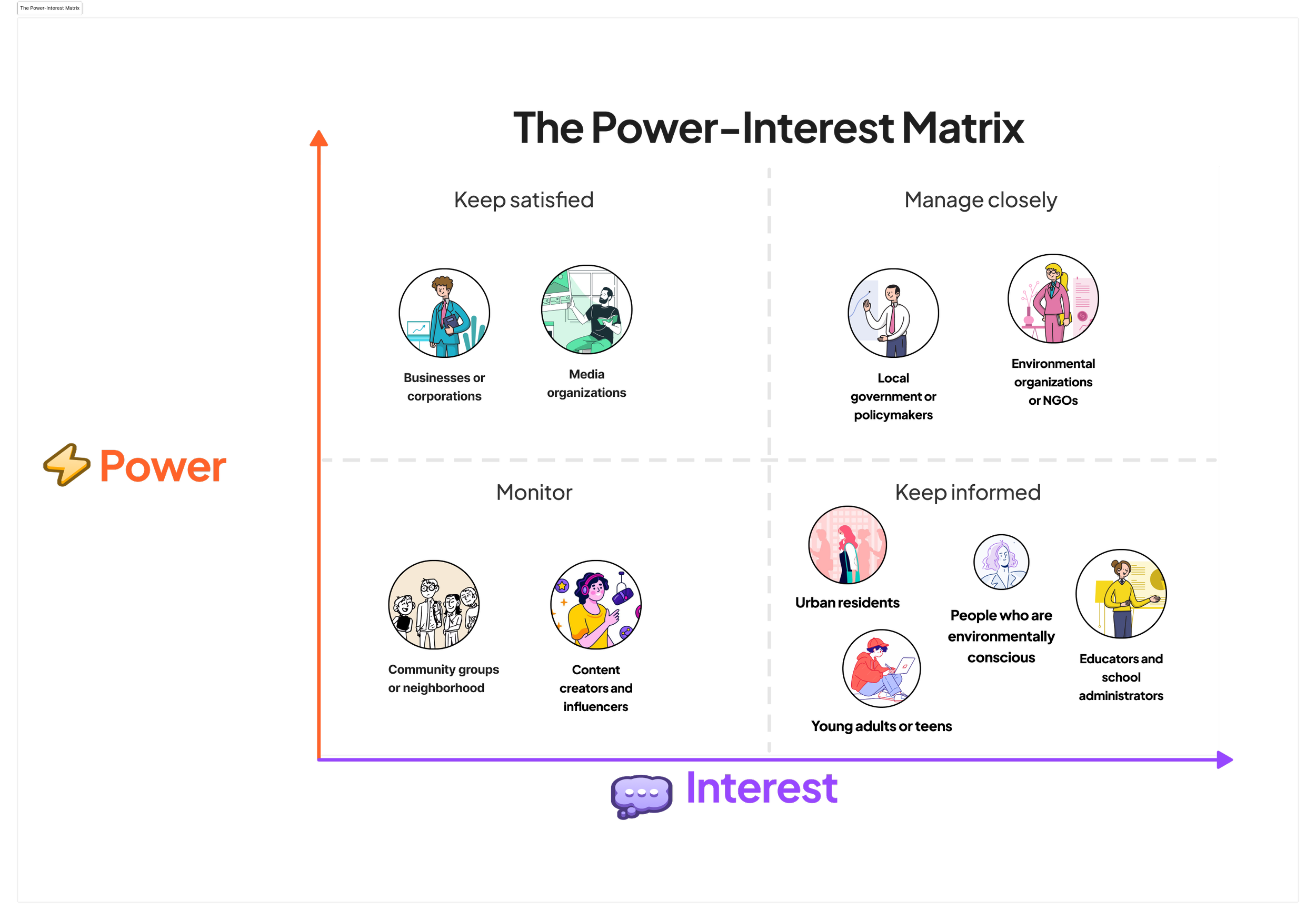Storyboard
Stakeholder Mapping
Core Audience: These are the people we’re really trying to reach. They’re the ones most affected by this project and who we want to inspire to connect more with nature and adopt eco-friendly habits.
Who They Are: Think young adults or teens who might be curious but don’t know much about the environment yet, people living in cities who don’t have much access to nature, and eco-conscious folks who want tips on going greener.
Direct Stakeholders: These groups or individuals play a big role in making this project happen. They’re not the main focus, but they help us reach the core audience and spread the message.
Who They Are: Educators, environmental groups or NGOs, local policymakers, and influencers who talk about sustainability. They can help teach, share, or even make policies that encourage people to reconnect with nature.
Secondary Stakeholders: These people or groups aren’t directly involved in the project, but they could still benefit from or support it.
Who They Are: Businesses, neighborhood groups, and media outlets. They can help spread awareness, support eco-friendly initiatives, or encourage sustainability within their networks.
UX research methods
Here are some UX research methods that can help me explore how people feel about nature and raise environmental awareness:
Interviews
Why: To get a sense of how people view their connection (or lack of it) with nature.
Example: I could chat with city dwellers about their relationship with the outdoors. I’d ask them what keeps them from spending more time outside and what environmental issues they care about (if any!). This helps reveal what might motivate or discourage them from eco-friendly behaviors.Fly-on-the-Wall Observation
Why: To see what people naturally do in green spaces without them feeling watched or influenced.
Example: I’d quietly hang out in a park or community garden and just observe. Do people relax, socialize, or seem curious about the plants around them? Seeing how they use these spaces can give me clues about how they engage (or don’t engage) with nature.Surveys
Why: To quickly gather a lot of data on people’s attitudes and habits around nature.
Example: I’d send out a survey asking people how often they go outdoors, how interested they are in learning about nature, and if they’re taking steps to be eco-friendly. This would give me a broad sense of people’s awareness and where they might need a nudge.Participant Observation
Why: To dive into nature-related activities with people and see how they really engage.
Example: I could join a local eco-event or nature walk and observe how people are interacting with the activity. Are they just there for fun, or do they seem genuinely interested in learning more? By joining in myself, I can better understand their motivations and challenges on a personal level.Behavioral Mapping
Why: To get a clear picture of where and how people interact with nature in public spaces.
Example: I could map out a popular park and track where people hang out most—whether it’s by benches, paths, or shaded areas. If I notice certain spots are popular, I could add signs with eco-tips or interactive features in those areas to boost awareness.Prototyping
Why: To test out new ideas for reconnecting people with nature.
Example: I could create an interactive app that guides users through nature trails, points out plants or wildlife, and gives eco-friendly tips or educational content. Then, I’d gather feedback to see if they find it useful, fun, or too complicated. This would show me which features actually get people excited about spending time in nature or raise their awareness.
These research methods help me gain a deeper, more relatable understanding of people’s current attitudes towards nature and what might inspire them to care more about the environment.
Case studies
3D Interactive Website
An Immersive Trailer for Opera North’s production
What is missing?
What Is Missing? is a multi-sited memorial created by Maya Lin to raise awareness through science-based artworks about the present sixth mass extinction of species, connect this loss of species to habitat degradation and loss, and emphasize that by protecting and restoring habitat, we can both reduce carbon emissions and protect species.
Uncommon Knowledge: Practices and Protocols for Environmental Information
The databases that landscape architects rely on to design future-oriented infrastructure—the SHP files and CSVs that describe a site’s climate, plants, and soils, often involve inadvertently appeal to extractive forms of knowledge production and storage. What if we were to design information infrastructures, both physical and digital, that are premised on collective ownership as opposed to existing systems that privatize, accumulate, and collect? This thesis responds to the contemporary environmental information economy at the site of Google’s first hyperscale data center in water stressed The Dalles, Oregon. On the ban
Rewild our planet
Augmented Reality, Web AR
An Immersive AR Nature Experience, a multi-sensory experience that repairs the connection between human beings and the natural world, based on the Netflix original documentary series Our Planet. This mobile ARCore application uses cutting edge immersive technologies to build compassion for our fragile world. Each realistic 3D biome emphasises the beauty of the natural world, but also the role humans play in reversing the loss of nature.
WWF Deutschland : Native Wildlife AR
WWF is accompanying wild animals that were once extinct in Germany on their way back. To support this mission of one of the largest international non-governmental organziations for wilderness preservation, we at Demodern developed a WebAR application to raise awareness about the endangered animals.
Wild Immersion Experiment Nature
Travel Through Nature, Solve Riddles and Encounter Animals in Augmented Reality. Engage in educational experiences with Augmented Reality (AR)! This interactive activity encourages collaboration as players work together to solve riddles and uncover virtual animals. It’s an innovative approach to deepening understanding and appreciation for wildlife.













